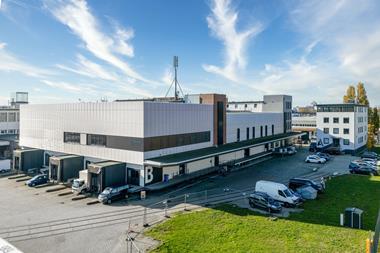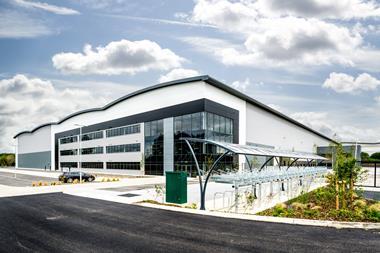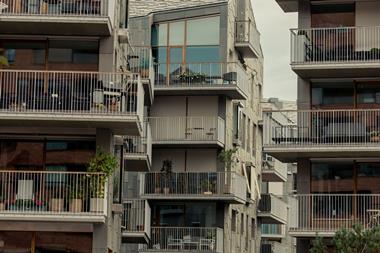Led by retail, Turkey's investment potential is growing fast but increasingly investors will have to look well beyond Istanbul for the best opportunities, Ermina Topintzi finds
The Turkish economy is in much better shape than it was early in this decade, although it remains vulnerable to external shocks as it integrates more deeply into the global flow of goods and capital.
Historically, its real estate market was affected by the country's significant political and economic instability but, in recent years, there has been steady progress towards an economic reform programme to support the country's candidacy to become a member of the EU.
For now however, the global credit squeeze, escalating political tensions and monetary tightening will weigh on economic growth in 2008. Increasing global risk aversion on the back of the US credit market turmoil has led to a deterioration in Turkey's financing outlook and in market sentiment overall.
While the Turkish economy has become more resilient to and flexible against international shocks, the credit crisis has led to a deterioration in market sentiment and created volatility in domestic financial markets. Downside risks are substantial, as the economy relies heavily on external financing.
The cost of market financing has increased and funding to domestic banks from securitised loans has contracted. But longer-term FDI decisions do not seem to have been greatly affected. The sub-prime crisis has not had a direct impact on banks, as the Turkish mortgage system does not allow sub-prime loans and banks are well regulated.
Absent any major negative political developments, the long-term forecast positive economic growth in the country in combination with the country's size and positive demographics should provide good investment opportunities in the local real estate market. Population growth, urbanisation, and a lack of modern office and retail product, especially in Turkey's Tier II cities, point to strong demand fundamentals.
About 500,000 new housing units annually will be needed over the next decade, and a mortgage law passed in 2007 will enable the mortgage system to develop. The retail sector spearheaded the evolution of Turkey's commercial property market. Within a few years, domestic retailers expanded and consolidated to form regional and national chains.
Cross-border retailers entered the market, benefiting from strong economic growth, limited legal barriers to entry and attracted by high growth potential. Approximately 190 shopping centres had been built in Turkey by February 2008, although most shopping centre developments were delayed until 2003, due to the contraction of the economy following the economic crisis in 2001.(1)
Ever since, the retail market has been the fastest-growing sector of Turkish real estate. The increasing wealth, the growing population and limited existing retail stock have fuelled retail development and provided a ready space solution for cross-border retailers keen to expand.
At 50m2 of modern shopping centre space per 1,000 inhabitants, Turkey's shopping centre stock is still relatively small; far below the levels in such mature markets as Sweden, France and the UK, which have in excess of 250m2 per 1,000 inhabitants. The low stock, however, not only represents pent-up demand but primarily reflects the lower wealth and spending potential.
A more accurate benchmark of market potential, consumer spending per square metre, shows that Turkey already looks stretched in its ability to absorb existing retail schemes, let alone those in the pipeline. At almost €21,000/m2, Turkey's consumers spend less per square metre than those in Sweden and in the Netherlands, which have established retail markets.
Shopping centre development has mainly targeted the densely populated districts of major cities such as Istanbul, Ankara, Izmir and Antalya. These four represent roughly 60% of Turkey's shopping centre stock, which is estimated at 3.5m m2. Istanbul alone comprises over 30%, with 47 shopping centres and a total gross leasable area (GLA) floorspace of about 1.5m m2.
Future pipeline in the country is enormous, with approximately 2.4m m2 to be completed by 2009. About 35 new shopping centres are under construction in Istanbul alone, with an additional 20-30 at planning stage.(2)
Due to saturation in some of the big Turkish cities and rapidly increasing land prices, many developers and institutional investors are forced to look to secondary cities such as Mersin, Samsun, Kocaeli and Diyarbakir. Until recently, retail investment has tended to target the western cities of Anatolia.
This will likely change in the next few years as incomes continue to grow across the country and saturation levels in the Tier-I cities drive investors east. This will be supported by the gradual shift in economic activity towards the centre and east, as companies are trying to reduce costs.
Compared with retail, the office sector in Turkey is still in its infancy. Attractive investment grade office space is primarily located in Istanbul, and even there it is limited.(3) Since the beginning of the decade, demand has been rising rapidly, with more foreign companies entering the market, and more local players expanding their businesses thanks to economic growth.
In Istanbul, the business and financial services sectors form the major source of demand, with letting activity mainly concentrated on the European side, where more office space exists.
The city's modern central business district (CBD) is stretched on a ‘strip' on the European side that crosses two separate boroughs and includes the areas of Levent, Esentepe, Zincirlikuyu and Maslak. The office buildings on the Asian side are mainly Class B but there is a big pipeline of prime office buildings in the short to medium term that should help increase occupier demand.
The office vacancy rate has been decreasing throughout all business districts of Istanbul in the last few years. This is particularly the case on the European side, where it is virtually zero for modern office stock in the areas of Levent and Maslak. Limited supply and strong occupier demand have put strong upward pressure on prime office rents, which have risen by more than 60% over the past three years.
Although the price differential between the two continents holds firmly, rents have grown strongly in all business districts, reaching US$40(€31)/m2 a month in Levent and close to US$20/m2 a month on the Asian side.
The upward pressure on rents is likely to continue, albeit at a moderate pace. On the one hand, the shortage of available land, coupled with high land prices, restricts further office space developments, particularly in the CBD. Moreover, the financial and economic slowdown means that fewer new enterprises will seek to enter the Turkish market in the next 24 months.
The current supply pipeline will then limit rental growth. The significant rent differentials within Istanbul together with the economic slowdown will force some office occupiers to relocate to new, emerging locations on the Asian side. Within the core CBD area, where land supply is restricted, we expect to see more refurbishments.
The government's latest proposal to move Turkey's Central Bank headquarters to Istanbul will positively affect the city's office market. Besides Istanbul, Antalya, Ankara, Kocaeli and Izmir are expected to generate fast growth in office demand.
Compared with western European countries (EU-25 average 2.5 persons) the average household size of 4.5 persons(4) in Turkey is still big and it is higher in the east. The last four decades witnessed a sharp decline from an average of 5.7 people, with a wide regional variation, however. We expect the overall trend of declining household size to persist and the growth rate of the household numbers to outstrip the population increase.
Our analysis predicts that household growth will be strongest in already more densely populated regions with smaller average household sizes. What is striking, due to outward migration, is that a few regions may actually experience falling household numbers over an extended period.
The he most recent building census of 2000 indicates there was no overall shortage of housing, given that there was a total of 16.2m housing units and 15.1m households.(5) However, this does not mean that residential markets even in regions with "excess" supply are unattractive to investors.
The building census figures encompass all dwellings regardless of their facilities and quality. More than 8% of buildings in Turkey were described as either in need of serious repair or in ruins. Second, only one-third of all housing units in Turkey had a building and utilisation licence in 2000, which is formally required to obtain a connection to utilities.(6)
A large share of the unlicensed buildings are officially considered substandard, not meeting safety and/or other regulations. This implies that a large part of the housing stock needs to be renewed. Affordability trends are difficult to capture but houses have become less affordable due to the higher cost of credit and the recent moderation in real income growth.
The top 20% income-strata can more easily purchase, but only a reduction in the cost of credit and an extension of maturity would enable a larger proportion of the population to exercise demand in the official and licensed real estate markets.(7)
Against this backdrop the high home ownership ratio in real estate of almost 70% can only be explained by traditional financing with savings of the extended family, the high preference for housing as an inflation hedge in storing wealth and the large share of unofficial construction.
Based on our forecast, we expect that 5.3m new housing units will be needed between 2007 and 2017. Another 500,000 additional housing units will be needed each year from 2018 to 2027. Rising interest rates and a weaker economy will weigh on housing affordability, thereby limiting house price growth for the next two years. The overall long-term outlook, however, remains intact, especially for good-quality housing units in city locations.
Following the expansion of the EU and the deeper integration of goods and capital markets across the continent, demand for logistics properties is set to shift towards Eastern Europe. Low labour costs, a favourable geographical location and high growth potential all point to an increasing demand for the industrial sector in Turkey. However, poor infrastructure is still a major handicap to Turkey's industrial market.
Transport is heavily dependent on roads, which carry over 90% of freight. In the past, container transport has been limited but transport volumes are increasing rapidly as a result of Bulgaria and Romania's recent growth spurt. The Black Sea area has witnessed strong growth in sea traffic in the last few years and Turkey benefits from container ports located along its 1,450km coastline. Privatisation of the ports has been a high priority for the Turkish government, trying to increase seaport capacity.
The industrial sector is still embryonic, with much of its existing stock being of poor quality. Within Turkey, Istanbul is the most developed industrial market. Ankara, Izmir and Mersin are also established industrial locations. Demand in Istanbul has been driven by local companies but international organisations are becoming increasingly prominent as the manufacturing and retail warehousing sectors expand.
Industrial site availability is limited in Istanbul's vicinity, and there is a severe shortage of modern space. Still, the development pipeline remains muted, with the majority of occupiers opting for ‘build-to-suit' space and speculative development staying low. Industrial rents in Istanbul experienced the highest growth among key European centres in the period 2003 to 2007 although industrial rent levels are still low at €57/m2/year even compared with eastern European markets.
The expansion of the retail sector will be a crucial factor for the industrial sector, and will increase the demand for retail warehousing. Larger companies will be more likely to outsource their logistics operations as competition in the market increases.
In addition, the areas surrounding major container ports (such as Istanbul, Izmir and Mersin) and airports (such as Antalya, Izmir, Adana, Trabzon and of course Istanbul) should also develop into key logistics locations as firms search for land with good transport connections. However, risks that could hamper the development of the sector are linked to rising land prices and the dependence on road transportation.
Footnotes
1 Jones Lang Lasalle (2008). Turkey Retail Commentary, April 2008.
2 King Sturge, Turkey Property Market 2008.
3 Partly this comes from the fact that co-ownership and flat ownership in buildings is quite common in Turkey. This makes transactions more difficult to handle.
4, 5 SIS, 2000 population census
6 See SPO, Annual Programme 2008, p. 117 on illicit electricity use, p. 133 on sewage connections and p. 206 on illegal water consumption.
7 See Binay, S., Salman, F. (2008), A Critique on Turkish Real Estate Market, Turkish Economic Association, Discussion Paper 2008/8, May 2008.
Pros
The underlying fundamentals, in the form of strong growth and a shortage of real estate product, are favourable. Prime yields still compare favourably with euro or US bond yields, but also with yields that can be obtained for comparable properties in the more sophisticated markets of Western and Central Europe.
Cons
Ermina Topintzi is head of quantitative analysis and eastern European strategy at RREEF Alternative Investment








![Henderson Park PBSA Edinburgh[100]](https://d15duu1h3gsd2d.cloudfront.net/Pictures/380x253/6/8/9/1338689_hendersonparkpbsaedinburgh100_507986.jpg)



